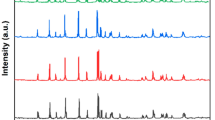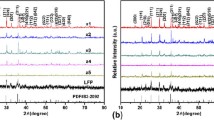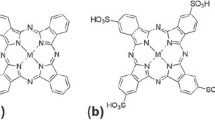Abstract
Lithium iron phosphate (LiFePO4) has been recommended as a hopeful cathode material for lithium ion batteries (LIBs) in the future due to its lots of advantages, such as stable operating voltage, excellent cycle performance, controllable cost, and environmental protection. However, pure LiFePO4 (LFP) shows bad reversible capacity and charge/discharge performance at high rate. Many methods including decrease of particle size, optimization of coating carbon, introduction of conductive polymer, and doping of metal or non-metallic element have been developed to improve the electrochemical performance of LFP cathode material. In this study, LFP/C-P composite cathodes were prepared successfully by a facile sol-gel approach that graphite was used to generate a carbon network structure and triphenylphosphine was used to greatly facilitate generation of a network connecting passage. Electrochemical test results show that LFP/C-P composite cathode has achieved a remarkable improvement in capacity and apparent ascension in rate performance. Compared with LFP, LFP/C, and LFP-P cathode, LFP/C-P composite material shows the best electrochemical performance with a discharge capacity of 168.8 mAh g−1 and a remarkable retention rate of 98.8% over 100 cycles at 0.1 C.












Similar content being viewed by others
References
Halankar KK, Mandal BP, Jangid MK, Mukhopadhyay A, Meena SS, Acharya R, Tyagi AK (2018) Optimization of lithium content in LiFePO4 for superior electrochemical performance: the role of impurities. RSC Adv 8:1140–1147
Lewerenz M, Marongiu A, Warnecke A, Sauer DU (2017) Differential voltage analysis as a tool for analyzing inhomogeneous aging: a case study for LiFePO4|graphite cylindrical cells. J Power Sources 368:57–67
Zhang C, Yan F, Du C et al (2017) Evaluating the degradation mechanism and state of health of LiFePO4 lithium-ion batteries in real-world plug-in hybrid electric vehicles application for different ageing paths. Energies 10:110–123
Zhang Y, Xin P, Yao Q (2018) Electrochemical performance of LiFePO4/C synthesized by sol-gel method as cathode for aqueous lithium ion batteries. J Alloys Compounds 741:404–408
Huang J, Wang J, Zhong H, Zhang L (2018) N-Cyanoethyl polyethylenimine as a water-soluble binder for LiFePO4, cathode in lithium-ion batteries. J Mater Sci 53:9690–9700
He J, Zhong H, Zhang L (2018) Water-soluble binder PAALi with terpene resin emulsion as tackifier for LiFePO4 cathode. J Appl Polym Sci 135:46132–46138
Fischer MG, Hua X, Wilts BD, Castillo-Martínez E, Steiner U (2018) Polymer-templated LiFePO4/C nanonetworks as high-performance cathode materials for lithium-ion batteries. ACS Appl Mater Interfaces 10:1646–1652
Chen YT, Zhang HY, Chen YM, Qin G, Lei XL, Liu LY (2018) Graphene-carbon nanotubes-modified LiFePO4 cathode materials for high-performance lithium-ion batteries. Mater Sci Forum 913:818–830
Zhang H, Chen Y, Zheng C, Zhang D, He C (2015) Enhancement of the electrochemical performance of LiFePO4/carbon nanotubes composite electrode for Li-ion batteries. Ionics 21:1813–1818
Qiu S, Zhang X, Li Y, Sun T, Wang C, Qin C (2016) Facile synthesis and electrochemical performances of secondary carbon-coated LiFePO4-C composite for Li-ion capacitors based on neutral aqueous electrolytes. J Mater Sci Mater Electron 27:7255–7264
Seo JH, Verlinde K, Guo J, Heidary DSB, Rajagopalan R, Mallouk TE, Randall CA (2018) Cold sintering approach to fabrication of high rate performance binderless LiFePO4, cathode with high volumetric capacity. Scr Mater 146:267–271
Wei X, Guan Y, Zheng X, Zhu Q, Shen J, Qiao N, Zhou S, Xu B (2018) Improvement on high rate performance of LiFePO4 cathodes using graphene as a conductive agent. Appl Surf Sci 440:748–754
Anseán D, Dubarry M, Devie A, Liaw BY, García VM, Viera JC, González M (2017) Operando lithium plating quantification and early detection of a commercial LiFePO4 cell cycled under dynamic driving schedule. J Power Sources 356:36–46
Madram AR, Daneshtalab R, Sovizi MR (2016) Effect of Na+ and K+ co-doping on the structure and electrochemical behaviors of LiFePO4/C cathode material for lithium-ion batteries. RSC Adv 6:101477–101484
Oh J, Lee J, Hwang T, Kim JM, Seoung KD, Piao Y (2017) Dual layer coating strategy utilizing N-doped carbon and reduced graphene oxide for high-performance LiFePO4, cathode material. Electrochim Acta 231:85–93
Naumann M, Schimpe M, Keil P, Hesse HC, Jossen A (2018) Analysis and modeling of calendar aging of a commercial LiFePO4/graphite cell. J Energy Storage 17:153–169
Gúeguen A, Castro L, Dedryvère R et al (2017) The electrode/electrolyte reactivity of LiFe0.33Mn0.67PO4 compared to LiFePO4. J Electrochem Soc 160:A387–A393
Wang P, Zhang G, Li Z et al (2016) Improved electrochemical performance of LiFePO4@N-doped carbon nanocomposites using polybenzoxazine as nitrogen and carbon sources. ACS Appl Mater Interfaces 8:141–149
Xiao P, Henkelman G (2018) Kinetic Monte Carlo study of Li intercalation in LiFePO4. ACS Nano 12:844–851
Panchal S, Dincer I, Agelin-Chaab M, Fowler M, Fraser R (2017) Uneven temperature and voltage distributions due to rapid discharge rates and different boundary conditions for series-connected LiFePO4, batteries. Int J Heat Mass Transfer 81:210–217
Jung WK, Baek C, Kim JH, Moon S, Kim DS, Jung YH, Kim DK (2018) A highly-aligned lamellar structure of ice-templated LiFePO4 cathode for enhanced rate capability. Mater Des 139:89–95
Gao L, Xu Z, Zhang S, Xu J, Tang K (2017) Enhanced electrochemical properties of LiFePO4 cathode materials by Co and Zr multi-doping. Solid State Ionics 305:52–56
Lachal M, Bouchet R, Boulineau A, Surblé S, Rossignol C, Alloin F, Obbade S (2017) Remarkable impact of grains boundaries on the chemical delithiation kinetics of LiFePO4. Solid State Ionics 300:187–194
Tong B, Wang J, Liu Z, Ma L, Zhou Z, Peng Z (2018) Identifying compatibility of lithium salts with LiFePO4 cathode using a symmetric cell. J Power Sources 384:80–85
Chen M, Kou K, Tu M, Hu J, du X, Yang B (2017) Conducting reduced graphene oxide wrapped LiFePO4/C nanocrystal as cathode material for high-rate lithium secondary batteries. Solid State Ionics 310:95–99
Zhu J, Sun Z, Wei X, Dai H (2017) Battery internal temperature estimation for LiFePO4 battery based on impedance phase shift under operating conditions. Energies 10:60–77
Feng W (2017) Effect of carbon nanotubes on the electrochemical performance of LiFePO4 particles in lithium ion batteries. Int J Electrochem Sci 10:5199–5207
Choi H, Kim HJ, Shim IB, Lee IK, Kim CS (2017) Structural and magnetic properties of lithium cathode materials LixFe1/3Co1/3Ni1/3PO4, (x = 0, 1). Mater Res Bull 93:361–365
Wu G, Liu N, Gao X, Tian X, Zhu Y, Zhou Y, Zhu Q (2018) A hydrothermally synthesized LiFePO4/C composite with superior low-temperature performance and cycle life. Appl Surf Sci 435:1329–1336
Yuksel T, Litster S, Viswanathan V, Michalek JJ (2017) Plug-in hybrid electric vehicle LiFePO4, battery life implications of thermal management, driving conditions, and regional climate. J Power Sources 338:49–64
Sood R, Iojoiu C, Espuche E et al (2017) Proton conducting ionic liquid doped nafion membranes: nano-structuration, transport properties and water sorption. J Physical Chem C 116:24413–24423
Lewerenz M, Münnix J, Schmalstieg J, Käbitz S, Knips M, Sauer DU (2017) Systematic aging of commercial LiFePO4 |graphite cylindrical cells including a theory explaining rise of capacity during aging. J Power Sources 345:254–263
Chaoui H, Ibe-Ekeocha CC, Gualous H (2017) Aging prediction and state of charge estimation of a LiFePO4, battery using input time-delayed neural networks. Electr Power Syst Res 146:189–197
Johnson ID, Ashton TE, Blagovidova E, Smales GJ, Lübke M, Baker PJ, Corr SA, Darr JA (2018) Mechanistic insights of Li+ diffusion within doped LiFePO4 from muon spectroscopy. Sci Rep 8:4114–4120
Tian X, Zhou Y, Tu X, Zhang Z, du G (2017) Well-dispersed LiFePO4, nanoparticles anchored on a three-dimensional graphene aerogel as high-performance positive electrode materials for lithium-ion batteries. J Power Sources 340:40–50
Wu YJ, Gu YJ, Chen YB, Liu HQ, Liu CQ (2018) Effect of lithium phosphate on the structural and electrochemical performance of nanocrystalline LiFePO4, cathode material with iron defects. Int J Hydrog Energy 43:2050–2056
He L, Zha W, Chen D (2017) Effects of organic phosphorus acid on the core-shell structure and electrochemical properties of LiFePO4 uniformly wrapped with in-situ growed graphene nanosheets. J Alloys Compounds 727:948–955
Kim MS, Lee GW, Lee SW et al (2017) Synthesis of LiFePO4/graphene microspheres while avoiding restacking of graphene sheet’s for high-rate lithium-ion batteries. J Ind Eng Chem 4(52):251–259
Du Y, Tang Y, Chang C (2017) Enhanced electrochemical performance from 3DG/LiFePO4/G sandwich cathode material. J Phys Chem Solids 107:36–41
Xiong QQ, Lou JJ, Teng XJ, Lu XX, Liu SY, Chi HZ, Ji ZG (2018) Controllable synthesis of N-C@LiFePO4, nanospheres as advanced cathode of lithium ion batteries. J Alloys Compounds 743:377–382
Bao L, Xu G, Sun X, Zeng H, Zhao R, Yang X, Shen G, Han G, Zhou S (2017) Mono-dispersed LiFePO4@C core-shell [001] nanorods for a high power Li-ion battery cathode. J Alloys Compounds 708:685–693
Okada K, Kimura I, Machida K (2018) High rate capability by sulfur-doping into LiFePO4 matrix. RSC Adv 8:5848–5853
Eftekhari A (2017) LiFePO4/C nanocomposites for lithium-ion batteries. J Power Sources 343:395–411
Gao Z, Cheng C, Woo W et al (2017) Integrated equivalent circuit and thermal model for simulation of temperature-dependent LiFePO4 battery in actual embedded application. Energies 10:85–107
Funding
This work is supported by the Natural Science Foundation of China (No. 21566021 and 21766017), the Transformation of Scientific and Technological Achievements of Gansu Institutions of Higher Education (No. 2017D-04), and the Supporting Plan for Youth Innovative Talents of Longyuan.
Author information
Authors and Affiliations
Corresponding author
Rights and permissions
About this article
Cite this article
Li, C., Xie, Y., Zhang, N. et al. Optimization of LiFePO4 cathode material based on phosphorus doped graphite network structure for lithium ion batteries. Ionics 25, 927–937 (2019). https://doi.org/10.1007/s11581-018-2744-7
Received:
Revised:
Accepted:
Published:
Issue Date:
DOI: https://doi.org/10.1007/s11581-018-2744-7




